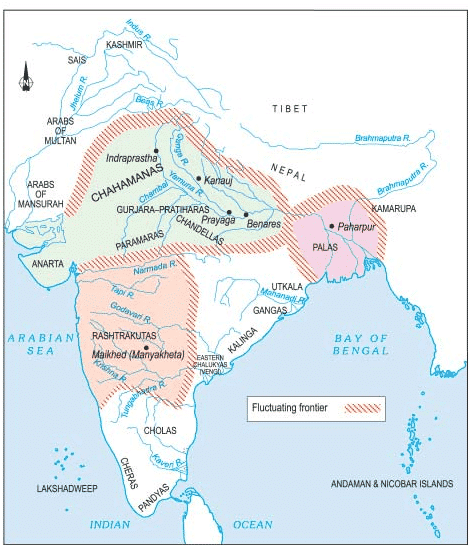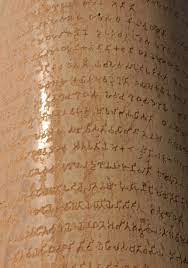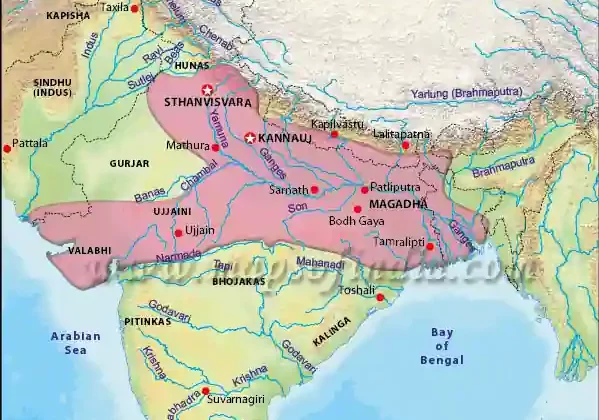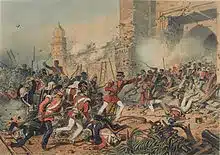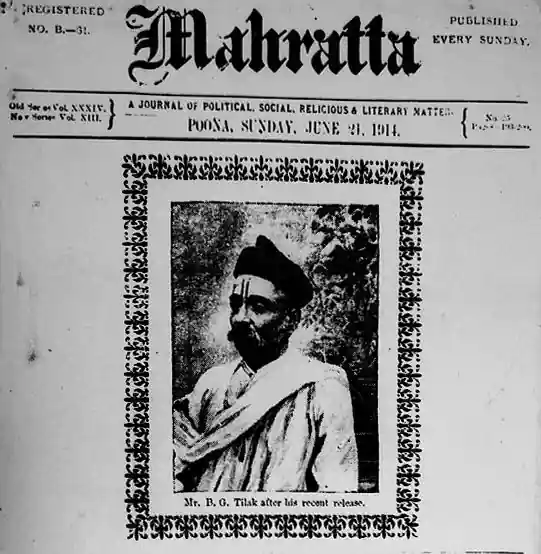Pre-Mauryan Dynasty of Magadh
The political conflict among the Mahajanapadas ultimately led to the emergence of Magadha as the most powerful state and the centre of a vast empire. It became the most powerful state in ancient India. Magadha is situated in modern Bihar. Jarasandha, who was a descendant of Brihadratha, founded the empire in Magadha. Both are talked about in the Mahabharata.
Haryanka Dynasty
Magadha’s rise to political supremacy began with Bimbisara, who belonged to the Haryanka dynasty, and ruled for 52 years, from 544 to 492 BCE. In the Mahavamsa, it is stated that he was anointed as the king by his father at the age of 15, which suggests that he was not the founder of his dynasty.
Bimbisara (558 BC – 491 BC)
He pursued a three-pronged policy, namely, matrimonial alliances, friendship with strong rulers, and conquest of weak neighbours to expand the empire.
- Son of Bhattiya.
- According to Buddhist chronicles, Bimbisara ruled for 52 years (544 BCE – 492 BCE).
- Contemporary and follower of the Buddha. Was also said to be an admirer of Mahavira, who was also his contemporary.
- Had his capital at Girivraja/Rajagriha (Rajgir). It was surrounded by 5 hills, the openings of which were closed by stone walls on all sides. This made Rajagriha impregnable.
- He was also known as Sreniya.
- He was the first king to have a standing army. Magadha came into prominence under his leadership.
- Jivaka – the first physician in Indian history and a student of Taxila University flourished in the court of Bimbisara.
- He had a rivalry with Avanti king Pradyota, but later became friends and Bimbsara even sent his royal physician Jivaka to Ujjain, when Pradyota had jaundice.
- He started the practice of using matrimonial alliances to strengthen his political position.
- He had three wives:
- His first wife was from Kosala named Mahakoshala or Kosaladevi (sister of Prasenjit), who brought in dowry the territory of Kashi, which yielded a revenue of 1,00,000 coins.
- Lichchhavi Princess Chellana from Vaishali, who gave birth to Ajatashatru.
- daughter of the chief of the Madra clan (Punjab).
- He followed a policy of conquest and expansion. The most notable conquest by Bimbisara was that of Anga.
- He had an effective and excellent administrative system. The officers occupying high posts were divided into three – executive, military and judicial.
Ajatasatru (492 BC – 460 BC)
- Son of Bimbisara and Chellana.
- He killed his father and became ruler.
- King Prasenajit immediately took back Kasi, which he had handed out as dowry to Bimbisara. This led to a military confrontation between Magadha and Kosala. The struggle lasted until Prasenajit was overthrown and died at Rajgriha, the capital of the Magadha Empire. Kosala was then annexed to Magadha.
- He embraced Buddhism.
- He was also known as Khunika meaning the greatest of the dynasty.
- He convened the First Buddhist Council at Rajagriha just after the death of Buddha in 483 BCE. Read more on Buddhist Councils here.
- Won wars against Kosala and Vaishali.
- Ajatashatru waged a war against Vaishali despite the fact that his mother was a Lichchhavi princess. It took him 16 long years to destroy Vaishali and add it to his empire.
- He is the presumed inventor of two weapons used in war: the rathamusala (scythed chariot) and the mahashilakantaka (engine to eject big stones).
- The ruler of Avanti tried to invade Magadha and to thwart this danger Ajatashatru began the fortification of Rajgriha. However, the invasion did not materialise during his lifetime.
- Assakara was his most powerful Chief Commander and was considered invincible.
Udayabhadra/Udayin (460 BCE – 444 BCE)
- Son of Ajatasatru.
- Shifted the capital to Pataliputra (Patna).
- Last of the major Haryanka rulers.
- Udayin’s reign is important because he built the fort upon the confluence of the rivers Ganga and Son at Pataliputra. This was done because Patna lay in the centre of the Magadha Kingdom, which now extended from the Himalayas in the north to the hills of the Chotanagpur in the south.
- He was killed at the behest of Palaka, the king of Avanti.
- Succeeded by three kings – Aniruddha, Manda and Nagadasaka.
Shishunaga Dynasty
According to Sri Lankan chronicles, the people of Magadha revolted during the reign of Nagadasaka and placed an amatya (minister) named Sisunaga as the king. Shishunaga dynasty lasted from 413 BCE to 345 BCE.
Shishunaga
- He was the viceroy of Kasi before becoming king of Magadha.
- The capital was at Girivaraja.
- The most important achievement of Shishunaga was the destruction of the power of Avanti with its capital at Ujjain. This brought to an end the 100-year-old rivalry between Magadha and Avanti. Avanti became a part of the Magadha empire and continued to be so till the end of the Mauryan rule.
- Later shifted the capital to Vaishali.
Kalasoka
- Son of Shishunaga.
- He may be of dark complexion as the contemporary Sri Lankan texts mention his name as Kakavarna (of color like a crow).
- Kalasoka shifted the capital to Pataliputra.
- He conducted the Second Buddhist Council at Vaishali.
- He was killed in a palace revolution that brought the Nanda dynasty to the throne.
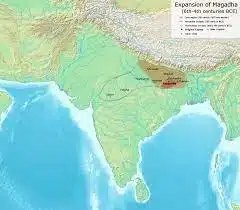
Nanda Dynasty
About a hundred years after Ajatashatru’s demise, the Nandas became the emperors of Magadha. This was the first non-Kshatriya dynasty and it lasted from 345 BCE to 321 BCE. The first ruler was Mahapadma Nanda who usurped the throne of Kalasoka.
Mahapadma Nanda
- He is called the “first historical emperor of India.” (Chandragupta Maurya is the First Emperor of India)
- He murdered Kalasoka to become the king.
- His origins are not clear. As per the Puranas, he was the son of the last Sisunaga king from a Sudra woman. As per some Jain texts and Greek writer Curtius, he was the son of a barber and a courtesan.
- Thus, the Nandas were considered adharmika (those who don’t follow the norms of Dharma). Buddhist texts describe the Nandas as belonging to annatakula (unknown lineage).
- His reign lasted for twenty-eight years.
- Also called Ugrasena in Pali texts, because of his large army.
- Also called “Sarvakshatrantaka” (destroyer of all the Kshatriyas), “Ekrat” (sole sovereign who destroyed all other ruling princes), and Eka-chchhatra (meant that he brought the whole earth under one umbrella).
- The empire grew under his reign. It ran from the Kuru country in the north to the Godavari Valley in the south and from Magadha in the east to Narmada on the west.
- He conquered many kingdoms.
- He added Kalinga to Magadha and brought an image of Jina as a victory trophy.
- He also acquired Kosala which had probably rebelled against him.
- Since he had one of the largest standing armies in the history of world {2 Lakh infantry, 8000 war chariots, 6000 elephants!}, he is also called Ugrasena.
- His army was so large that he could arrange it in a lotus shape {Padmavyuh} and he was so wealthy that his wealth could be counted in Padma (One quadrillion).
- He subdued all the contemporary powers and consolidated the power of Magadha.
Dhana Nanda
- He was the last Nanda ruler.
- He is referred to as Agrammes or Xandrames in Greek texts.
- Alexander invaded North-Western India during his reign, but he could not proceed towards the Gangetic plains because of his army’s refusal.
- Dhana Nanda inherited a huge empire from his father. He possessed a standing army of 200,000 infantry, 20,000 cavalry, 3000 elephants and 2000 chariots. He became a powerful ruler because of this.
- He is said to be one of the 8 or 9 sons of Mahapadma Nanda.
- He is credited with the invention of Nandopakramani (a particular measure).
- He became unpopular with his subjects owing to an oppressive way of extorting taxes. Also, his Sudra origins and an anti-Kshatriya policy led to a large number of enemies.
- Finally, he was overthrown by Chandragupta Maurya along with Chanakya, who took advantage of the public resentment and established the Maurya Empire in Magadha.
Related Links:
| INDUS VALLEY CIVILIZATION | Mahajanapadas |
| Vedic Period | Vedic Literature |
| Marriages In the Later Vedic Period | MCQs: History Of Ancient India |


